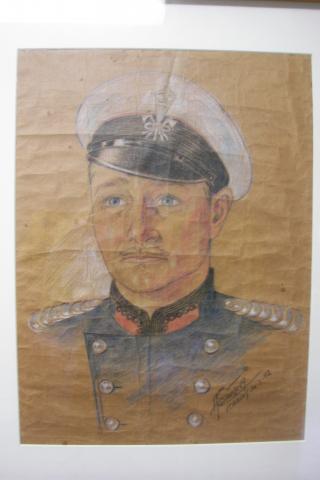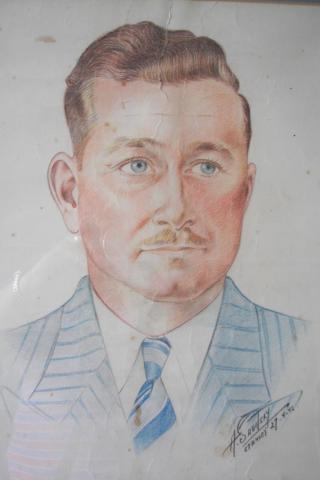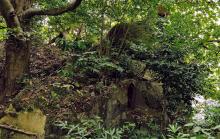AJ Savitsky's portraits in Stanley Internment Camp
Primary tabs
AJ Savitsky was an artist interned in the Stanley Prison Camp during World War II, when the Japanese occupied Hong Kong. He was a Russian who had migrated to Hong Kong in the early 1930s and became a member of the Hong Kong Police Reserve in 1936. He was interned with other civilians, including police officers.
Apparently Savitsky did some 200 portraits whilst in the Camp and should be recognized for these extraordinary works. Yes – extraordinary when one considers his dedication in producing these portraits despite the considerable lack of materials, and secondly, for rendering such a unique and accomplished record of so many of the internees.
Below are two drawings done by AJ Savitsky of Ron (Roland) Brooks who was an officer in the Hong Kong Fire Brigade, prior to the Japanese invasion. The first portrait, on brown wrapping paper, depicts Ron in his Fire Brigade uniform (dated 30 March 1942):
The second is a portrait in civilian clothes (dated 27 April 1942).:
Suziepie




Comments
Portraits by Savitsky
Suziepie, thanks for sharing these. It's amazing to think the circumstances they were drawn under, and also amazing they've survived.
I wonder how many more of Savitsky's portraits still exist?
Regards, David
Re: Portraits by Savitsky
Thanks Suziepie!
A few years ago, many sketches done in an internment camp in Hong Kong during the war were published in a book. I seem to recall that the surname of the person who did the sketches also starts with an "S". I wonder if he was Mr. Savitsky?
Re: Sketches
I think the sketches that you were referring to are the drawings from Lt. A. V. Skvorzov which was published into a book entitled "Hong Kong POW Camp Life."
AJ Savitsky
Hi Everyone,
AJ Savitsky is my grandfather! Known as Joe Savitsky.
[Admin: I've moved the rest of Michael's comments to the page for AJ Savitsky, but here are the comments relevant to the portraits:]
After surrender, he left hospital and ended up in Stanley Camp.
Pretty soon after he arrived, the Japanese Camp Commandant found out he was an artist and asked to have his portrait painted and grandfather agreed. However he had none of the necessary art supplies so that Japanese organised to get art supplies from his mother-in-law who was still living in Kowloon (as she was Russian, not British). It really was thanks to her that many of the portraits and drawings were done in Stanley (and also that invaluable documentation also survived the war - a remarkable effort for a caucasian woman in her 50s to survive in Kowloon for 3.5 years!).
I'm also a member of the Stanley Camp discussion group (I started it up) so more info can be found there:http://groups.yahoo.com/group/stanley_camp
He survived captivity, did 200 odd paintings and drawings which we have found many examples all over the world.
Hi David, We have some at
Hi David,
We have some at home and have found his portraits all over the world!
Michael
Joe Savitsky's portraits
Hi Michael,
Thanks very much for writing. I'm interested to learn more about Joe's portraits:
The few we've seen (listed in the "Pages" section at top-right of this page) are all from early 1942. Did he continue drawing right through the internment, or did he run out of drawing materials, and / or the energy to keep drawing?
The portraits here all show a view imagining the subject in happier times, dressed in their uniforms or suits. They must have been a great help to keep people's spirits up. Did he also draw any views showing actual conditions in the camp?
Regards, David
PS Thanks for starting the Stanley discussion group. Thats a great resource for anyone interested in that period of Hong Kong's history.
Hi David, I believe that he
Hi David,
I believe that he kept drawing all throughout his internment but I'll ask Dad. He can confirm this.
I'd love to one day maybe put them all into a book.
Michael
SAVITSKY'S PORTRAITS
Hi Michael
It is a great idea to put the portraits in a book - I hope you do manage to get a good collection of them. How many have you found so far? It would be such a unique recording of that period of history in Hong Kong. Good luck.
Suziepie
Savitsky's portraits
Thanks to Cyril Martin (Joe Savitsky's son, Michael Martin's father) for answering several questions about these portraits:
Q1 The few we've seen (listed in the "Pages" section at top-right of corner of http://gwulo.com/node/12007) are all from early 1942. Did he continue drawing right through the internment, or did he run out of drawing materials, and / or the energy to keep drawing?
A1. The drawings we have are dated between 1943 to 1945. (The dates on his drawing were mainly the year only and in some cases even the last 2 or 3 digits were missing.)
The following list are the paintings/copies that are currently in our possession:-
1. Book cover for "an eastern cadet's anecdotage" by Andrew Guilmore 1943
2. Portrait of Lance Searle 1943
3. Collin Luscombe - No date, missing from scan.
4. Belgian Family- Husbands role. 26-8-1944
5. Belgian Family- Husband 1943
6. Belgian Family- Wife. 1943 (I believe one of her parents was Russian)
7. Belgian Family- Anniversary 1945
8. Belgian Family- Happy Days are here again. 1945
9. Sgt. F. Zadorin (Police- originally Anti Piracy Guard, 1930) 1943
10. Sgt. Vic Veriga (Water Police- originally Anti Piracy Guard, 1930) 1943
We are currently trying to enlarge our search for more drawings.
Q2 The portraits here all show a view imagining the subject in happier times, dressed in their uniforms or suits. They must have been a great help to keep people's spirits up. Did he also draw any views showing actual conditions in the camp?
A2. I really don't know if he intentionally drew them in a happy mood, its possible that he did to ease the burden of camp life (I don't remember if he mentioned it, Michael might remember).
He may have drawn scenes, but I don't think so as he would have possibly tried to extend his stock of materials. Apart from portraits I remember that my father mentioned that he painted posters for some concerts and events that were held in Stanley.